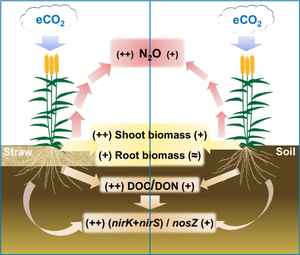Biology and Fertility of Soils ( IF 5.1 ) Pub Date : 2024-09-21 , DOI: 10.1007/s00374-024-01866-1 Shengji Yan, Yunlong Liu, Daniel Revillini, Manuel Delgado-Baquerizo, Kees Jan van Groenigen, Ziyin Shang, Xin Zhang, Haoyu Qian, Yu Jiang, Aixing Deng, Pete Smith, Yanfeng Ding, Weijian Zhang

|
Nitrous oxide (N2O) is one of the most important climate-forcing gases, and a large portion of global anthropogenic N2O emissions come from agricultural soils. Yet, how contrasting global change factors and agricultural management can interact to drive N2O emissions remains poorly understood. Here, conducted within a rice–wheat cropping system, we combined a two-year field experiment with two pot experiments to investigate the influences of elevated atmospheric carbon dioxide (eCO2) and crop straw addition to soil in altering N2O emissions under wheat cropping. Our analyses identified consistent and significant interactions between eCO2 and straw addition, whereby eCO2 increased N2O emissions (+ 19.9%) only when straw was added, and independent of different N fertilizer gradients and wheat varieties. Compared with the control (i.e., ambient CO2 without straw addition), eCO2 + straw addition increased N2O emission by 44.7% and dissolved organic carbon to total dissolved nitrogen (DOC/TDN) ratio by 115.3%. Similarly, eCO2 and straw addition significantly impacted soil N2O-related microbial activity. For instance, the ratio of the abundance of N2O production genes (i.e., nirK and nirS) to the abundance of the N2O reduction gene (i.e., nosZ) with straw addition was 26.0% higher than that without straw under eCO2. This indicates an increased denitrification potential and suggests a change in the stoichiometry of denitrification products, affecting the balance between N2O production and reduction, leading to an increase in N2O emissions. Taken together, our results emphasize the critical role of the interaction between the specific agronomic practice of straw addition and eCO2 in shaping greenhouse gas emissions in the wheat production system studied, and underline the need to test the efficacy of greenhouse gas mitigation measures under various management practices and global change scenarios.
Graphical abstract
中文翻译:

提高 CO2 浓度和秸秆改良剂对稻麦种植系统 N2O 排放的协同效应
一氧化二氮 (N 2 O) 是最重要的气候影响气体之一,全球人为 N 2 O 排放量的很大一部分来自农业土壤。然而,对比鲜明的全球变化因素和农业管理如何相互作用以推动 N 2 O 排放仍知之甚少。在这里,我们在稻麦种植系统中进行了为期两年的田间试验和两次盆栽试验,以研究大气中二氧化碳 (eCO 2 ) 升高和向土壤中添加农作物秸秆对改变小麦下 N 2 O 排放量的影响裁剪。我们的分析发现,eCO 2和秸秆添加之间存在一致且显着的相互作用,即仅当添加秸秆时,eCO 2才会增加 N 2 O 排放量 (+ 19.9%),并且与不同的氮肥梯度和小麦品种无关。与对照(即不添加秸秆的环境CO 2 )相比,eCO 2 +秸秆添加使N 2 O排放量增加了44.7%,溶解有机碳与总溶解氮(DOC/TDN)的比率增加了115.3%。同样,eCO 2和秸秆添加显着影响土壤N 2 O相关微生物活性。例如,在eCO 2条件下,添加秸秆的N 2 O生产基因(即nirK和nirS )与N 2 O还原基因(即nosZ )的丰度之比比不添加秸秆的高26.0%。 。 这表明反硝化潜力增加,并表明反硝化产物的化学计量发生变化,影响N 2 O产生和还原之间的平衡,导致N 2 O排放增加。综上所述,我们的结果强调了秸秆添加的具体农艺实践与 eCO 2之间的相互作用在影响所研究的小麦生产系统中温室气体排放方面的关键作用,并强调需要测试不同条件下温室气体减排措施的有效性。管理实践和全球变化情景。


















































 京公网安备 11010802027423号
京公网安备 11010802027423号